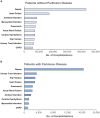Complications and outcomes of hospitalizations for patients with and without Parkinson disease
- PMID: 38161593
- PMCID: PMC10757345
- DOI: 10.3389/fnagi.2023.1276731
Complications and outcomes of hospitalizations for patients with and without Parkinson disease
Abstract
Objective: To examine complications and outcomes of hospitalizations for common indications for hospitalization among patients with Parkinson disease (PD).
Methods: We identified and selected the ten most common indications for hospitalization among individuals ≥65 years of age using principal diagnoses from the California State Inpatient Database, 2018-2020. Patients with comorbid PD were identified using secondary diagnosis codes and matched one-to-one to patients without PD based on principal diagnosis (exact matching), age, gender, race and ethnicity, and Elixhauser comorbidity index (coarsened exact matching). We identified potentially preventable complications based on the absence of present on admission indicators among secondary diagnoses. In the matched cohort, we compared inpatient complications, early Do-Not-Resuscitate (DNR) orders (placed within 24 h of admission), use of life-sustaining therapies, new nursing facility requirement on discharge, and death or hospice discharge for patients with and without PD.
Results: We identified 35,457 patients with PD among the ten leading indications for hospitalization in older adults who were matched one-to-one to patients without PD (n = 70,914 in total). Comorbid PD was associated with an increased odds of developing aspiration pneumonia (OR 1.17 95% CI 1.02-1.35) and delirium (OR 1.11 95% CI 1.02-1.22) during admission. Patients with PD had greater odds of early DNR orders [placed within 24 h of admission] (OR 1.34 95% CI 1.29-1.39). While there was no difference in the odds of mechanical ventilation (OR 1.04 95% CI 0.98-1.11), patients with PD demonstrated greater odds of tracheostomy (OR 1.41 95% CI 1.12-1.77) and gastrostomy placement (OR 2.00 95% CI 1.82-2.20). PD was associated with greater odds of new nursing facility requirement upon discharge (OR 1.58 95% CI 1.53-1.64). Patients with PD were more likely to die as a result of their hospitalization (OR 1.11 95% CI 1.06-1.16).
Conclusion: Patients with PD are at greater risk of developing aspiration pneumonia and delirium as a complication of their hospitalization. While patients with PD more often have early DNR orders, they have greater utilization of life-sustaining therapies and experience worse outcomes of their hospitalization including new nursing facility requirement upon discharge and greater mortality.
Keywords: Parkinson disease; aspiration; complications; delirium; epidemiology; hospitalization; mortality; outcomes.
Copyright © 2023 George, Barbosa, Sethi and Richard.
Conflict of interest statement
The authors declare that the research was conducted in the absence of any commercial or financial relationships that could be construed as a potential conflict of interest.
Figures





Similar articles
-
Association of Do-Not-Resuscitate orders and in-hospital mortality among patients undergoing cranial neurosurgery.J Clin Neurosci. 2023 Dec;118:26-33. doi: 10.1016/j.jocn.2023.10.006. Epub 2023 Oct 17. J Clin Neurosci. 2023. PMID: 37857061
-
Racial and Ethnic Differences in the Prevalence of Do-Not-Resuscitate Orders among Older Adults with Severe Traumatic Brain Injury.J Intensive Care Med. 2022 Dec;37(12):1641-1647. doi: 10.1177/08850666221103780. Epub 2022 May 22. J Intensive Care Med. 2022. PMID: 35603747
-
Association of Postoperative Delirium and Parkinson Disease After Common United States Surgical Procedures.J Surg Res. 2023 Nov;291:711-719. doi: 10.1016/j.jss.2023.06.051. Epub 2023 Aug 9. J Surg Res. 2023. PMID: 37566934
-
Are hospitalized Parkinson's disease patients more likely to carry a do-not-resuscitate order?J Clin Neurosci. 2017 Mar;37:57-58. doi: 10.1016/j.jocn.2016.10.031. Epub 2016 Oct 31. J Clin Neurosci. 2017. PMID: 27810417
-
Do-Not-Resuscitate Orders in Older Adults During Hospitalization: A Propensity Score-Matched Analysis.J Am Geriatr Soc. 2018 May;66(5):924-929. doi: 10.1111/jgs.15347. Epub 2018 Apr 20. J Am Geriatr Soc. 2018. PMID: 29676777
Cited by
-
Risk of aspiration pneumonia and hospital mortality in Parkinson disease: A systematic review and meta-analysis.Eur J Neurol. 2024 Dec;31(12):e16449. doi: 10.1111/ene.16449. Epub 2024 Sep 5. Eur J Neurol. 2024. PMID: 39236309 Free PMC article.
-
Association Between Levodopa with Inotrope Prescription and Mechanical Ventilation Dependence in People with Parkinson's Disease upon Septic Shock.J Clin Med. 2025 Jan 24;14(3):748. doi: 10.3390/jcm14030748. J Clin Med. 2025. PMID: 39941417 Free PMC article.
References
-
- 3M™ Health Care Academy (2023). 3M™ potentially preventable complications (PPC) classification system: methodology overview. Available at: https://multimedia.3m.com/mws/media/1666313O/3m-potentially-preventable-... (Accessed August 5, 2023)
-
- Aminoff M. J., Christine C. W., Friedman J. H., Chou K. L., Lyons K. E., Pahwa R., et al. . (2011). Management of the hospitalized patient with Parkinson's disease: current state of the field and need for guidelines. Parkinsonism Relat. Disord. 17, 139–145. doi: 10.1016/j.parkreldis.2010.11.009 - DOI - PMC - PubMed
-
- Asch D. A., Islam M. N., Sheils N. E., Chen Y., Doshi J. A., Buresh J., et al. . (2021). Patient and hospital factors associated with differences in mortality rates among black and white US medicare beneficiaries hospitalized with COVID-19 infection. JAMA Netw. Open 4:e2112842. doi: 10.1001/jamanetworkopen.2021.12842 - DOI - PMC - PubMed
LinkOut - more resources
Full Text Sources

